Institute of Oceanology, Chinese Academy of Sciences
Article Information
- ZONG Tong, HAN Xiqiu, LIU Jiqiang, WANG Yejian, QIU Zhongyan, YU Xing
- Fractional crystallization processes of magma beneath the Carlsberg Ridge (57°-65°E)
- Journal of Oceanology and Limnology, 38(1): 75-92
- http://dx.doi.org/10.1007/s00343-019-8328-1
Article History
- Received Sep. 24, 2018
- accepted in principle Jan. 10, 2019
- accepted for publication Mar. 21, 2019
2 Key Laboratory of Submarine Geosciences, State Oceanic Administration & Second Institute of Oceanography, Ministry of Natural Resources, Hangzhou 310012, China;
3 Ocean College, Zhejiang University, Zhoushan 316021, China;
4 School of Oceanography, Shanghai Jiaotong University, Shanghai 200030, China
Mid-ocean ridge basalts (MORBs) are generated by partial decompression melting of the upper mantle caused by ridge spreading, hence providing insight into the geochemical composition of the mantle sources. They generally undergo variable degrees of fractional crystallization at different depths, including within the crust or mantle, before eruption to the seafloor (Grove et al., 1992; Michael and Cornell, 1998; Herzberg, 2004; Villiger et al., 2007); hence, the compositions of MORBs cannot represent the composition of primary magmas (Langmuir et al., 1992; Grove et al., 1992; Michael and Cornell, 1998; Le Roux et al., 2002; Herzberg, 2004; O'Neill and Jenner, 2012; Coogan and O'Hara, 2015; Herzberg and Asimow, 2015). Major element and trace element variations in MORBs reflect the continuous evolution of the parental basaltic magmas along olivine (Ol) or olivine ± plagioclase (Plg) or olivine ± plagioclase ± clinopyroxene (Cpx) cotectics (Grove et al., 1992; Danyushevsky, 2001; Almeev et al., 2008). For example, crystallization of olivine (or olivine + clinopyroxene) can lead to a decrease in MgO contents in the melt, and crystallization of plagioclase results in decreasing Al2O3 (Danyushevsky, 2001). These processes have been demonstrated by fractional and equilibrium crystallization experimental studies (e.g., Villiger et al., 2004, 2007). Therefore, to investigate the geochemical composition of the mantle sources of MORBs, evaluating the effect of partial crystallization of the magma is required.
Petrological evidence has shown that crystallization begins below the crust-mantle transition (e.g., Grove et al., 1992; Kelemen et al., 2007; Collier and Kelemen, 2010). The calculated crystallization pressures based on the major elements and/or volatiles (CO2 and H2O) in global MORBs have suggested that crystallization occurs in the crust and upper mantle (from 1 atm to 10 kbar) and that it becomes more variable with decreasing spreading rate in general (Herzberg, 2004; Villiger et al., 2007; Wanless and Behn, 2017). The magma fluxes at fastspreading ridges are higher than those at slowspreading ridges. The basaltic melts in magma chambers at fast-spreading ridges can be sustained over longer times and generally have undergone relatively sufficient differentiation (Detrick et al., 1990; Sinton and Detrick, 1992). Along fastspreading ridges, magma crystallization usually occurs within the crust beneath the segment centres but can occur both in the mantle and crust if it is beneath the segment terminations (Herzberg, 2004; Villiger et al., 2007). In contrast, fractional crystallization is not significant at either slowspreading or ultraslow-spreading ridges because their magma chambers are commonly non-existent or unstable due to lower magma supply (Sinton and Detrick, 1992; Michael and Cornell, 1998). Along slow-spreading ridges, crystallization starts dominantly within the upper mantle (Herzberg, 2004; Villiger et al., 2007).
Carlsberg Ridge is a typical slow-spreading ridge. The limited studies on the geochemistry of basalts suggest that fractional crystallization significantly impacts their compositions (Banerjee and Iyer, 1991, 2003; Iyer and Banerjee, 1993, 1998; Ray et al., 2013; Chun et al., 2015; Chen et al., 2017; Huang et al., 2017). However, the crystallization conditions of magmas are unclear. Additionally, the effects of crystallization conditions on the chemical variations in MORBs along the Carlsberg Ridge remain unsolved. In this paper, we analysed the major and trace element data of recently collected basalts from the Carlsberg Ridge between 57°E and 65°E and combined them with published geochemical data to evaluate the conditions of magma fractional crystallization and its effects on the chemical evolution of basaltic magmas. We found that the mantle sources beneath the Carlsberg Ridge are heterogeneous even on the scale of a local segment and that crystallization beneath this slow-spreading ridge may start at upper mantle depths.
2 SAMPLE AND ANALYTICAL TECHNIQUEIn total, 20 fresh basalt samples were analysed for this study. The basalt samples were collected by TVgrab (TVG) during the Chinese DY26, DY28 and DY33 cruises along the Carlsberg Ridge between 57°E and 65°E and at water depths between 1 800 and 4 100 m (Fig. 1, Table 1).
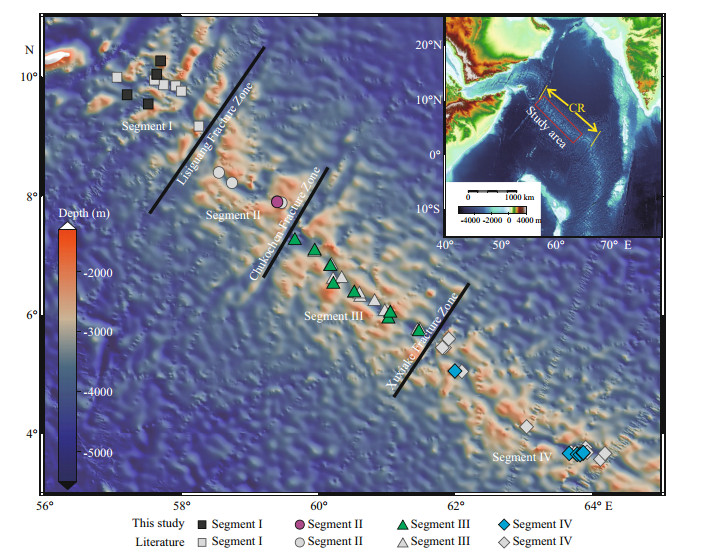
|
| Fig.1 A bathymetric map showing the sampling locations of basalts from the Carlsberg Ridge between 57°E and 65°E The symbols with dark colours represent the dredge location of the samples in this study, and the symbols with grey symbols are from Chen et al. (2017), Chun et al. (2015), Gale et al. (2014), Murton and Rona (2015), and Ray et al. (2013). |
 |
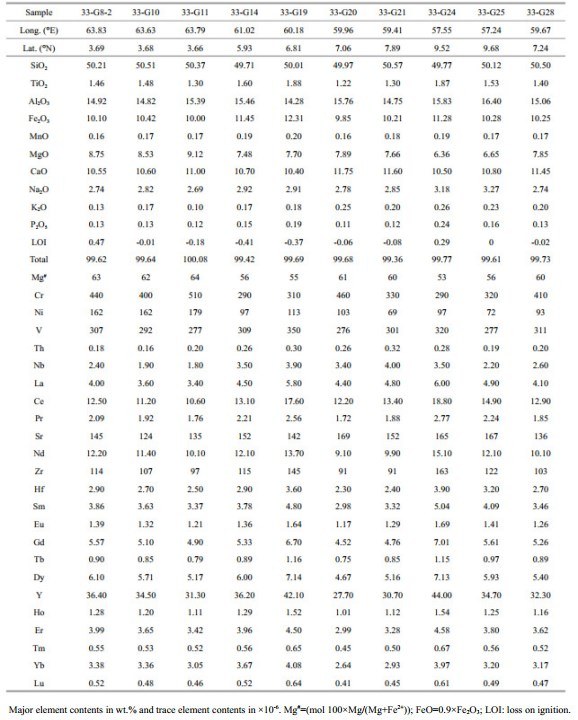
|
Major and trace element analyses were conducted at ALS Chemex (Guangzhou) Co. Ltd., China. The major element analysis was carried out using X-ray fluorescence spectrometry (XRF, instrument model: PANalytical Axios). Trace and rare earth elements were determined by inductively coupled plasma mass spectrometry (ICP-MS, instrument model: Agilent 7700X). The analytical results for standards used to monitor the data quality are listed in appendix A. In addition, multiple samples were used to monitor the repeatability. The analytical precisions of analyses for major elements (except for P2O5) and loss on ignition (LOI) were better than 5%. The analytical precisions of analyses for all the trace and rare elements were better than ±10%.
3 RESULT 3.1 PetrographyThe basalt samples studied are generally aphyric, with phenocrysts accounting for only ~5%–10%. Plagioclase is the most common phenocryst phase, followed by olivine and clinopyroxene. The chemical compositions of phenocrysts and micro-phenocrysts have been analysed via electron probe and reported by Chun (2015). The plagioclase phenocrysts (An52–86Ab14–46Or0.01–1.47) are mainly labradorite and bytownite. However, the plagioclase microphenocrysts (An58–68Ab31–41Or0.07–1.06) are labradorite. Most plagioclase phenocrysts are compositionally zoned but not plagioclase micro-phenocrysts. All olivine is chrysolite (Fo70–87), with no identifiable compositional zoning. Clinopyroxene is characterized by Wo7–48En29–64Fs10–36, including augite, diopside, and pigeonite, although they are rarely observed.
3.2 Major and trace elementsThe geochemical data for the basalt samples analysed in this study are listed in Table 1. These data are supplemented by published geochemical data for basalts from the Carlsberg Ridge (Ray et al., 2013; Gale et al., 2014; Chun et al., 2015; Murton and Rona, 2015; Chen et al., 2017). The Fe oxides reported as Fe2O3 were recalculated to FeOT using the method of Gale et al. (2013). For those published data with no reported MnO or P2O5 contents, we calculated their values according to Gale et al. (2013), where MnO=FeOT/54 and P2O5 was estimated using a polynomial best-fit equation based on K2O contents. Then, the measured oxide contents were renormalized to a sum of 100% anhydrous.
The SiO2 concentrations of the newly analysed samples are relatively constant (50.47–51.38 wt.%). MgO contents show a wide range from 9.19 wt.% to values as low as 6.03 wt.%, with Mg# (mol 100×Mg/ (Mg + Fe2+)) values from 51 to 64. Al2O3 (14.45–16.74 wt.%), FeOT (8.70–11.21 wt.%), CaO (10.37– 11.90 wt.%) and Na2O (2.71–3.53 wt.%) have relatively small variations. The minor element oxides TiO2 and K2O display slightly wide ranges from 1.24 to 2.02 wt.% and from 0.10 to 0.31 wt.%, respectively. The CaO/Al2O3 ratios range from 0.66 to 0.79. K2O/TiO2 ratios vary from 0.08 to 0.20.
The major element oxides versus MgO content of lavas erupted along the Carlsberg Ridge are shown in Fig. 2 (data from this study and the literature). The major elements of all samples analysed in this study cover and extend the variation ranges of the published glasses and whole-rock samples. Overall, TiO2, FeOT, Na2O, and K2O contents increase with decreasing MgO concentrations, CaO decreases with decreasing MgO, and Al2O3 does not vary systematically. CaO/Al2O3 ratios slightly increase with decreasing MgO content when MgO > 9 wt.% and decrease with decreasing MgO content when MgO < 9 wt.%. K2O/TiO2 ratios are almost constant when MgO > 9 wt.% and increase significantly with decreasing MgO content when MgO < 9 wt.%.

|
| Fig.2 Plots showing correlations of MgO with TiO2 (a), Al2O3 (b), FeOT (c), CaO (d), Na2O (e), K2O (f), CaO/Al2O3 (g) and K2O/TiO2 (h) of basalt samples from the Carlsberg Ridge between 57°E and 65°E Basalt data from this study are plotted in comparison with a compilation of published MORB data from the Carlsberg Ridge. |
At the segment scale, the MORBs from segment I have the largest variations in MgO (6–10.5 wt.%), TiO2, Na2O and K2O contents compared to the MORBs from other segments. The glass samples with the highest MgO contents have the lowest TiO2, FeOT, Na2O, and K2O but highest CaO contents (Fig. 2). The MORBs from segment Ⅱ have narrow major element content variations but wide K2O/TiO2 ratio ranges. The MORBs from segment Ⅲ and segment Ⅳ have similar chemical variations. At MgO > 8 wt.%, the Al2O3 and CaO contents of MORBs from segment Ⅲ are higher but contents of TiO2, FeOT, Na2O and K2O are lower than those of MORBs from segment Ⅳ. At MgO > 8 wt.%, the K2O/TiO2 ratios of MORBs from both ridges are nearly constant and narrow in range, but at MgO < 8 wt.%, the values remain constant while ranging more widely. In addition, at a given MgO content, the MORBs from segment Ⅱ and segment Ⅲ have higher CaO/Al2O3 ratios than those from segment I and segment Ⅳ.
Primitive mantle-normalized trace element variations and a chondrite-normalized rare earth element (REE) diagram for the samples analysed in this study are shown in Fig. 3. Clearly, all of the samples from the 4 different segments have similar trace element and REE patterns. They are similar to typical normal MORB (N-MORB) and depleted MORB (D-MORB), with (La/Sm)N=0.62–0.93, although the contents of some samples are higher than average D-MORB and average N-MORB. Negative Sr and Eu anomalies are present in more evolved samples with higher trace element and REE contents, reflecting plagioclase fractionation, whereas no or small Eu anomalies are found in the samples with less evolved compositions. The ranges in absolute abundances of the trace elements and REEs reflect the effects of mantle melting and crystal fractionation on the geochemical characteristics of basaltic samples.

|
| Fig.3 Primitive mantle-normalized trace element (a) and Chondrite-normalized rare earth element abundances (b) for basalt samples from the Carlsberg Ridge between 57°E and 65°E D-MORB, N-MORB and E-MORB are from Gale et al. (2013). |
The MORB samples we analysed also display wide ranges of trace element contents (e.g., Th (0.16– 0.36)×10-6 and Nb (1.8–4.7)×10-6) and ratios of trace elements (e.g., Zr/Nb=22.75–56.55 and Th/Nb=0.07– 0.13). The concentrations of trace elements can be affected by fractional crystallization, but the ratios of incompatible trace elements are less affected. Figure 4 shows the relationships of the trace element contents and their ratios with MgO content. Except for a few samples, the chemical variations of the remaining samples are consistent with the evolutionary trend of primitive basaltic magma. The compatible elements such as Cr, Ni and Eu/Eu* decrease systematically with decreasing MgO, whereas the incompatible elements Sr, Zr and Eu increase with decreasing MgO. All samples tested in this study form good evolutionary trends consistent with those of MORBs from the Carlsberg Ridge reported in the literature except the glass samples with the highest MgO contents from segment I, they have the lowest incompatible trace element (Sr, Zr) content (see Fig. 4). In contrast with trace element contents, the (La/Sm)N and Th/Nb ratios remain nearly constant with varying MgO content despite the slightly wide variation range.
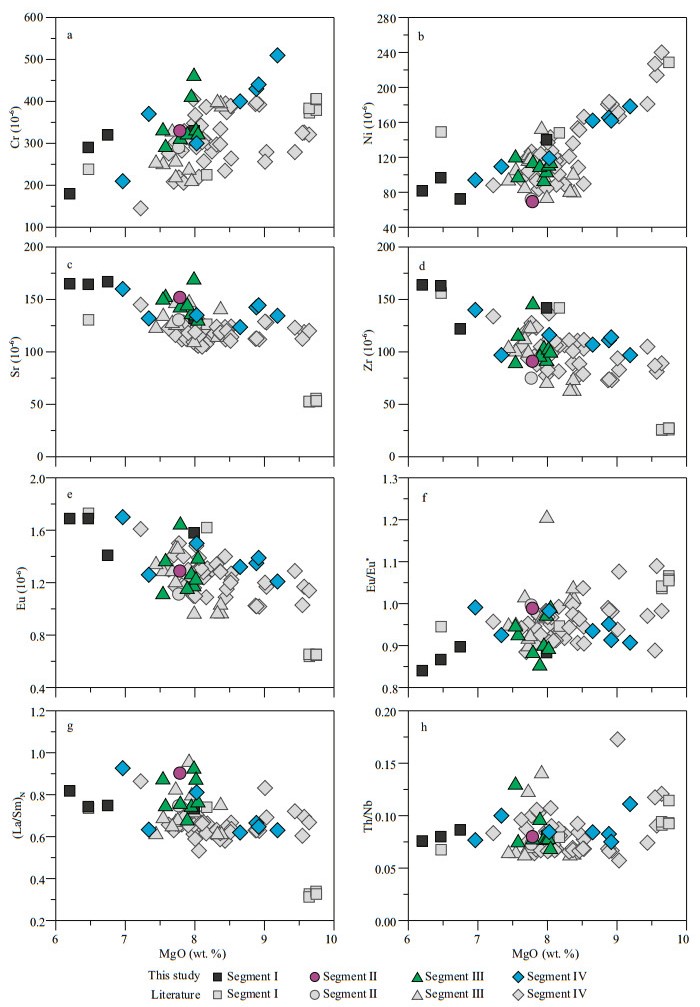
|
| Fig.4 Trace element variation diagrams for basalt samples from the Carlsberg Ridge |
The mantle source composition is the main controlling factor on the chemical compositions of MORBs, although processes such as mantle-melt interaction, fractional crystallization and magma mixing in magma chambers also affect MORB compositions (e.g., Hofmann, 2003; Niu and O'Hara, 2008; Arevalo and McDonough, 2010; Rampone and Hofmann, 2012). In particular, for ridge segments with similar spreading rates and mantle potential temperatures, the effect of mantle composition is the most important factor. Thus, we should first discuss the effect of mantle composition on the chemical variation in MORBs before we discuss the crystallization process. The melting of heterogeneous mantle results in chemically heterogeneous primitive melts that may experience different crystallization processes to form MORBs with different compositions. The similarities between the normalized REE and trace element patterns of basalts from segment I to segment Ⅳ indicate that these MORBs were likely derived from an N-MORB-type mantle source. The differences in the element contents of these MORBs may be caused either by differences in the mantle composition or by differences in the melting degree of upper mantle sources with similar compositions.
Moreover, fractional crystallization also causes variations in the element contents of these MORBs (Figs. 2 and 4a–4e). Compared with the element contents, the ratios of incompatible trace elements (e.g., K2O/TiO2 and (La/Sm)N), especially those with similar incompatibilities/partition coefficients (e.g., Th/Nb and Nb/La), are less influenced by mantle melting and crystallization. K2O/TiO2, (La/Sm)N, Th/ Nb, and Nb/La ratios are regarded as good indicators of mantle source composition because of similar incompatibilities for these element pairs. At the scale of segments or even a local region (for example, ~64°E), these four ratios display slightly wide variation ranges, whereas along the whole ridge, these four ratios are nearly constant (Fig. 5). In addition, Na 72 values (Na2O content at Mg#=72 for basaltic melt; Niu and O'Hara, 2008; Niu, 2016) of MORBs, representing the degree of mantle melting, show no correlations with (La/Sm)N, Th/Nb, and Nb/La ratios (Fig. 6a–c). This result indicates that the degree of mantle melting is not the main factor responsible for the wide range of chemical compositions (Zhang, 2016). The wide variations in these ratios indicate that the mantle source beneath the Carlsberg Ridge is heterogeneous and that heterogeneous mantle sources are ubiquitous beneath the Carlsberg Ridge. The role of pyroxenite in peridotite mantle sources has been suggested for the wide chemical variation (e.g., Sobolev et al., 2007; Zhang et al., 2012; Brunelli et al., 2018), but the effect of pyroxenite on our samples is negligible based on the FeOT/MnO ratios (Howarth and Harris, 2017) (Fig. 6d). The Sr-Nd-Pb isotope data of MORBs from Carlsberg Ridge showed that the mantle source has been contaminated by different amounts of continental crust components (the "DUPAL" anomaly) (Ray et al., 2013; Chen et al., 2017 and the references therein). Therefore, the mantle heterogeneity may be caused by the enriched components resulting in the "DUPAL" anomaly.
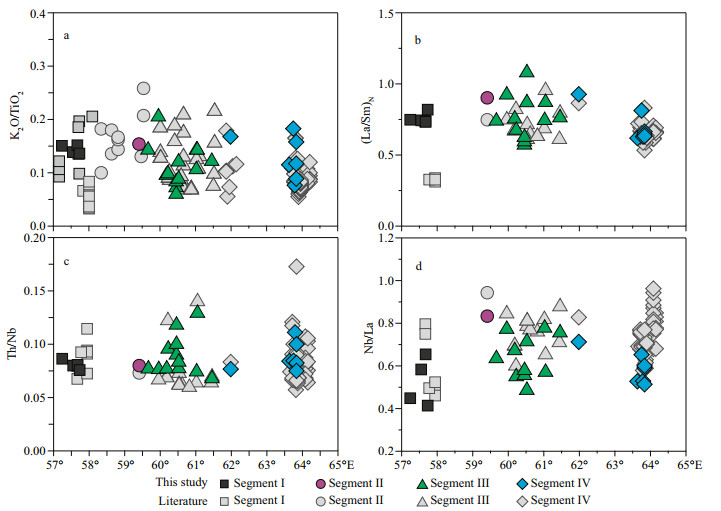
|
| Fig.5 The variations in K2O/TiO2 (a), (La/Sm)N(b), Th/Nb (c), and Nb/La (d) ratios for MORBs along the Carlsberg Ridge |
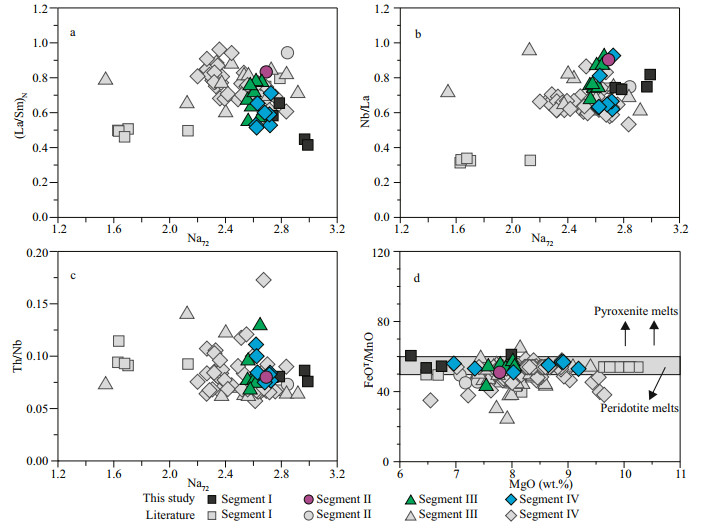
|
| Fig.6 The (La/Sm)N (a), Nb/La (b), Th/Nb (c) ratios versus Na72 and FeOT/MnO versus MgO content (d) for MORBs along the Carlsberg Ridge |
Some of the reported glass samples collected at ~58°E have the lowest (La/Sm)N (Fig. 5) and the lowest Na72 values, which are generally regarded as good indicators of the degree of mantle melting (F; Klein and Langmuir, 1987). The lower Na72 values (higher F) of these samples seem to explain the lower (La/Sm)N because the incompatibilities of La and Sm are not perfectly equal. If so, the thickness of the oceanic crust at ~58°E should be greater than those of other segments. However, the oceanic crust of segment I is thinner than those of other segments (Fig. 1). Thus, the lower (La/Sm)N and Na2O values of MORBs from ~58°E should reflect mantle heterogeneity, although their Nb/La and Th/Nb ratios are similar to the rest of the MORBs. In addition, these basaltic glasses from ~58°E have lower Tb/Yb and Dy/Yb ratios than the remaining MORBs. Garnet is the main phase that can fractionate Tb/Yb and Dy/ Yb (Langmuir et al., 2006; Shinjo et al., 2015), and the lower Tb/Yb and Dy/Yb ratios thus may be caused by the lesser role of garnet in the mantle source. Therefore, high Al2O3 may reflect the lesser role of garnet in the mantle, although the higher Al2O3 contents of basalts at a given MgO content can be explained by water-bearing crystallization of hydrous melt and high-pressure crystallization of clinopyroxene (Sinton and Fryer, 1987; Green, 1976; Michael and Cornell, 1998; Eason and Sinton, 2006).
4.2 Evidence for fractional crystallizationThe geochemical characteristics of MORB samples from the Carlsberg Ridge between 57°E and 65°E (Figs. 2 and 4) imply that magmas beneath the Carlsberg Ridge must have experienced variable extents of fractional crystallization during their ascent from the melting region to eruption. For example, the Mg# values of most MORBs (Table 1) are below the value expected for typical primary magmas (Almeev et al., 2008; Niu and O'Hara, 2008). The increasing FeOT content and decreasing Al2O3 and Ni with decreasing MgO content indicate fractional crystallization along the Ol + Plg cotectic. Fractional crystallization of olivine, plagioclase and clinopyroxene can lead to different correlations between CaO/Al2O3 or CaO and MgO content (Fig. 2g). The decreases in CaO contents and CaO/ Al2O3 ratios with decreasing MgO content may be related to fractionation of the Ol + Plg + Cpx mineral assemblage (Fig. 2; Rhodes and Dungan, 2013). The crystallization and precipitation of crystals from the melt would produce increases in incompatible trace elements (such as Zr and Sr) and decreases in compatible trace elements (such as Cr and Ni) with decreasing MgO content (Fig. 4). In addition, the negative Eu anomalies in evolved samples (Fig. 3) and the positive correlation between Eu/Eu* and MgO (Fig. 4f) reflect plagioclase fractional crystallization.
4.3 Forward modelling for the effect of fractional crystallizationTo understand the effect of the fractionation process on the chemical composition of MORBs along the Carlsberg Ridge, we performed forward modelling of liquid lines of descent (LLDs) of primary magmas using the Petrolog3 program (Danyushevsky and Plechov, 2011). The mantle source beneath the Carlsberg Ridge is heterogeneous based on the major and trace elements of MORBs (Fig. 5). The parental magmas of these MORBs must be inherited from the heterogeneous mantle and thus have different chemical compositions. Hence, we used several different parental magmas as starting compositions for the simulations. Because the MORBs have experienced variable degrees of fractional crystallization, their compositions cannot represent those of parental magmas. One or more basalts with high MgO and with olivine crystals only (i.e., Le Roux et al., 2002) were selected to estimate the parental magma compositions and then corrected for olivine fractionation to give an Mg#=~70 (Almeev et al., 2008) or Mg#=~72 (Niu and O'Hara, 2008). The primary magma compositions were estimated with Mg#=72 (Fo=90) using the method of le Roux et al. (2002). The crystallization calculations were performed under various pressures without water. The oxygen fugacity was buffered by quartz-fayalitemagnetite (QFM), and the model for the melt oxidation state was from Borisov and Shapkin (1990). Mineral-melt models for olivine, plagioclase and clinopyroxene followed Ford et al. (1983), Weaver and Langmuir (1990) and Ariskin et al. (1993), respectively. Calculations were stopped at 5 wt.% melt MgO content. The main mineral assemblages for modeled LLDs of a parental magma (red lines in Fig. 7) under 1 atm and 2, 4, 6, 8 and 10 kbar are listed in Table 2.
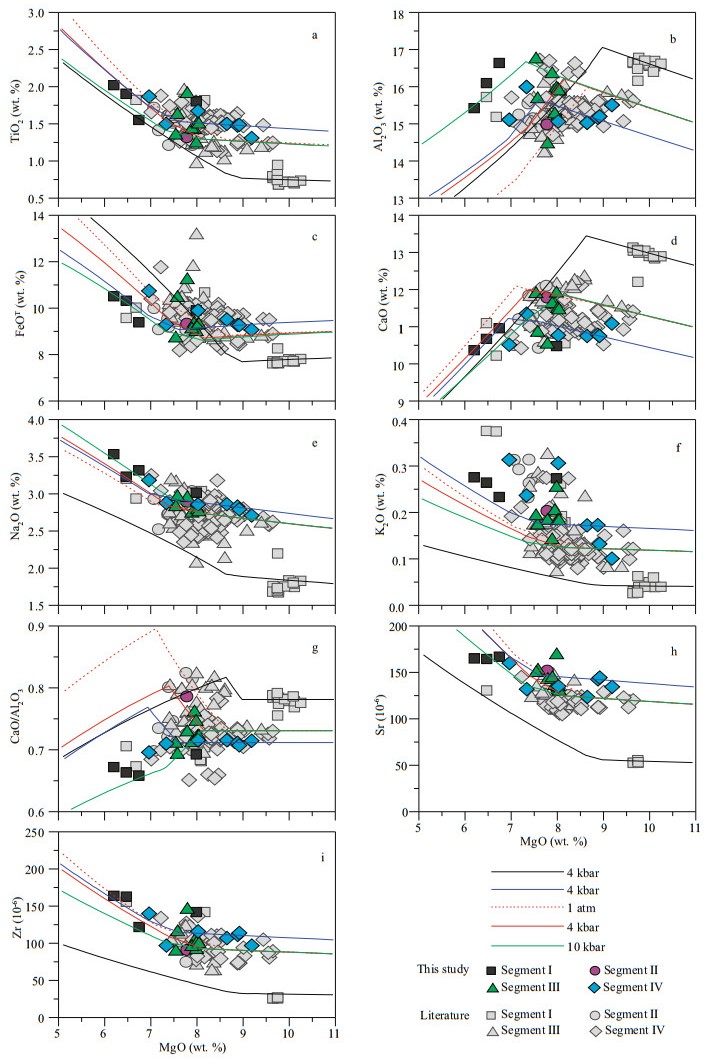
|
| Fig.7 Representative major element and trace element variation diagrams for MORBs from the Carlsberg Ridge, with superimposed isobaric liquid lines of descent for fractional crystallization calculated with the Petrolog3 program of Danyushevsky and Plechov (2011) |
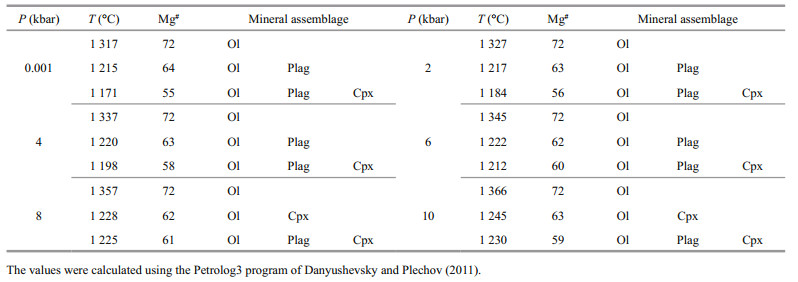
|
A comparison between natural petrochemical trends in MORBs and experimental compositions obtained from an assumed initial magma is used to characterize the conditions for magma crystallization (Almeev et al., 2008). If the natural petrochemical trends are similar to the experimental LLDs, the conditions modelled in the experiment may be similar to those in nature. However, the LLDs are affected by parental magma compositions and crystallization conditions, and the starting composition and crystallization conditions are not accurately obtained (Le Roux et al., 2002). In comparison to quantitative matching between simulated LLDs and natural petrochemical trends, paying attention to the mineral assemblage at different starting compositions and modelled conditions is more important.
Natural chemical variations in MORBs from the Carlsberg Ridge and modelled LLDs for 3 different parental magmas are shown in Fig. 7. The LLDs modelled from different starting compositions at the same pressures are nearly parallel despite the differences in detail. For a given starting composition, increasing pressure can result in different LLDs because clinopyroxene begins to crystallize at higher temperatures with increasing pressure. The beginning of clinopyroxene crystallization can be indicated by the change in slope of the LLDs in MgO versus CaO and MgO versus Al2O3 diagrams. When clinopyroxene joins the crystallizing assemblage, the CaO and CaO/ Al2O3 ratios start to decrease with decreasing MgO (Fig. 7d and g). At a pressure of 2 kbar, for example, olivine begins to crystallize at ~1 327℃ when the Mg# is ~72, and plagioclase starts to crystallize at ~1 217℃ when the Mg# is ~63 to form the olivine + plagioclase cotectic, followed by the olivine + plagioclase + clinopyroxene cotectic at ~1 184℃ when the Mg# is ~56. However, at a pressure of 8 kbar, clinopyroxene begins to crystallize earlier at ~1 228℃ when the Mg# is ~62 to form the olivine + clinopyroxene cotectic, and then plagioclase begins to crystallize (Table 2 and Fig. 7). Although the preferential crystallization of clinopyroxene at higher pressures changes the LLDs, the LLDs of a given parental magma at variable pressures form a series of parallel trends for olivine ± plagioclase ± clinopyroxene crystallization.
Figure 7 shows that the calculated LLDs have variation trends similar to the natural petrochemical trends of major and trace elements. The evolution of magmas beneath the Carlsberg Ridge may be consistent with nearly anhydrous LLDs modelled under 1 atm-10 kbar conditions. The comparison between LLDs and the natural compositions of MORBs indicates that the MORBs sampled from the Carlsberg Ridge are products of the crystallization of multiple parental magmas. The compositions of MORBs with the lowest (La/Sm)N from segment I imply that only crystallization of olivine occurred for their parental magma. While the chemical variations in the remaining MORBs may have been controlled by the crystallization of olivine ± plagioclase ± clinopyroxene cotectic (Table 2, Fig. 7).
Note that the chemical compositions of basalts from the Carlsberg Ridge cannot be explained only by fractional crystallization. For example, near ~ 8 wt.% MgO, the Al2O3 and CaO contents in basalts vary widely (Fig. 7b and d). In addition, the excessive increases in incompatible minor and trace elements (e.g., K2O and Zr) with MgO content in MORBs from the Carlsberg Ridge is consistently greater than those allowed from fractional crystallization, which indicates that the MORBs must have experienced other processes during magma upwelling. In view of this phenomenon, O'Neill and Jenner (2012) proposed a model in which the magma chamber is periodically refilled with fresh parental melt, which mixes with the pre-existing melt and is then tapped by volcanoes. Coogan and O'Hara (2015) further developed this model and suggested that in situ crystallization in a magma chamber undergoing replenishment and tapping can well explain the over-enrichment in incompatible trace elements in MORBs.
4.4 Pressures of crystallizationThe compositional variations and the calculated LLDs suggest that clinopyroxene had joined the olivine and plagioclase cotectic for the parental magmas of many MORBs. The clinopyroxene saturation temperature depends on pressure (Bender et al., 1978) and thus can be used to estimate the pressures (depths) of basaltic magmas equilibrated with an olivine + plagioclase + clinopyroxene mineral assemblage (Almeev et al., 2008).
Previous studies have provided several means for calculating the pressures of crystallization of basaltic magmas beneath mid-ocean ridges, including major element barometers (Grove et al., 1992; Danyushevskyl et al., 1996; Yang et al., 1996; Michael and Cornell, 1998; Herzberg, 2004; Villiger et al., 2007), vapour saturation pressures in inclusions (Wanless and Shaw, 2012; Wanless and Behn, 2017), and petrologic modelling (Almeev et al., 2008; Wanless and Behn, 2017). Among these methods, petrologic modeling of major elements is effective for a suite of lavas with genetic relationships. However, the chemical variations have shown that the mantle sources beneath a ridge segment are heterogeneous; thus, the compositions must be related to the parental magmas. In addition, the selection of the starting composition has a strong impact on the pressure estimation of fractional crystallization (Fig. 6). Evaluating which model leads to the most accurate result is difficult (Michael and Cornell, 1998; Almeev et al., 2008). Although the crystallization pressures calculated by these major element barometers and petrologic modelling are not the same, they are approximately consistent within the uncertainties of calculations (Almeev et al., 2008; Wanless and Behn, 2017). The pressure estimate from petrologic modelling is in best agreement with those calculated by Yang et al. (1996). Michael and Cornell (1998) rearranged and discussed the algorithms of Yang et al. (1996). The PCa equation of Michael and Cornell (1998) is the least sensitive to analytical uncertainties (Michael and Cornell, 1998; le Roux et al., 2002). In this paper, we calculate partial crystallization pressures of magmas using the PCa equation of Michael and Cornell (1998) (PCa (kbar)=[XCa– 1.133+0.569(XNa)+0.776(XK)+0.672(XTi)+0.214(XFe)+ 3.355(XSi)–2.83(XSi)2]/(-0.00339), where Xiis the molar fraction of element i). For comparison, we also show the pressure estimation results using the method of Villiger et al. (2007) (P(kbar)=[CaO–3.98(±0.17)– 14.96(±0.34)×Mg#]/[-0.260(±0.008)]). The crystallization pressures calculated by both methods are based only on major elements, and more chemical data can therefore be used.
The calculations are applicable to basalts that are saturated in clinopyroxene and plagioclase. Thus, we should first confirm clinopyroxene and plagioclase crystallization. Clinopyroxene crystallization can result in a positive correlation between CaO and MgO contents; therefore, the correlation between CaO and MgO can be used for the data screen. For our samples, the olivine + clinopyroxene + plagioclase cotectic could start at Mg#=61 when the pressure is up to 8 kbar (Table 2). Therefore, we select basalts with Mg#≤61 for pressure estimation, although Villiger et al. (2007) noted that the crystallization pressures calculated by their method are overestimated for basalts with high Mg# values (Mg# > 60).
Our calculation shows that the estimated crystallization pressures obtained with the method of Michael and Cornell (1998) are slightly lower than those calculated by the method of Villiger et al. (2007) (Fig. 8). However, they are approximately consistent, as Almeev et al. (2008) suggested. The crystallization pressures for basalts from the Carlsberg Ridge between 57°E and 65°E span a large variation range. The pressures estimated by the method of Michael and Cornell (1998) show that the majority of MORBs formed at pressures between 2 kbar and 7 kbar and from 2 kbar to 8 kbar as calculated with the method of Villiger et al. (2007). The calculated crystallization pressures are similar to those for other slow-spreading mid-ocean ridges such as the Mid-Atlantic Ridge (Michael and Cornell, 1998; Le Roux et al., 2002; Herzberg, 2004; Villiger et al., 2007) but are relatively higher than those for fast-spreading mid-ocean ridges such as the East Pacific Rise. The crystallization pressures indicate that crystallization beneath the Carlsberg Ridge may start within upper mantle depths, which is consistent with the previous observation for crystallization beneath slow-spreading and ultraslow-spreading mid-ocean ridges (le Roux et al., 2002; Herzberg, 2004; Villiger et al., 2007; Wanless and Behn, 2017). Compared with fastspreading mid-ocean ridges, the high crystallization pressure at slow-spreading mid-ocean ridges may result from the relatively cold mantle environment, low melt fraction, low magma supply and slight heat transfer to the surface (Michael and Cornell, 1998; Herzberg, 2004).

|
| Fig.8 Calculated pressures of crystallization of MORB from the Carlsberg Ridge versus longitude (57°–65°E) The pressures were calculated using the methods of Michael and Cornell (1998) (a) and Villiger et al. (2007) (b). |
The MORB samples collected from the Carlsberg Ridge between 57°E and 65°E range from moderately primitive (Mg#=65) to evolved (Mg#=51). The mantle sources beneath the Carlsberg Ridge are heterogeneous even at the scale of a local segment, and heterogeneous mantle sources may be ubiquitous beneath the Carlsberg Ridge. Mantle heterogeneity may be caused by the enriched components resulting in the "DUPAL" anomaly, while the effect of pyroxenite on mantle heterogeneity is negligible. The parental melts experienced the crystallization of olivine, plagioclase and clinopyroxene prior to eruption, which played a significant role in the major and trace element variations in MORBs from the Carlsberg Ridge. The liquid lines of descent, deduced from the forward modelling of three parental magma compositions using the Petrolog3 program at pressures between 1 atm and 10 kbar, demonstrate that clinopyroxene joined the olivine and plagioclase cotectic. The overenrichment in highly incompatible elements relative to LLDs may have been caused by the processes of replenishment-tapping-crystallization in magma chambers. The pressures calculated by the methods of Michael and Cornell (1998) and Villiger et al. (2007) show that the parental magmas beneath the Carlsberg Ridge experienced moderate- to high-pressure crystallization. In other words, crystallization beneath the slow-spreading Carlsberg Ridge may start at upper mantle depths.
6 DATA AVAILABILITY STATEMENTThe data that support the findings of this study are available from the corresponding author upon reasonable request.
7 ACKNOWLEDGEMENTWe would like to thank the captains, crews, and scientific parties who participated in the DY26th, DY28th and DY33th cruises for their indispensable cooperation during the sampling. This manuscript benefited greatly from the comments of two anonymous reviewers.
Almeev R, Holtz F, Koepke J, Haase K, Devey C. 2008. Depths of partial crystallization of H2O-bearing MORB:phase equilibria simulations of basalts at the MAR near Ascension Island (7-11°S). Journal of Petrology, 49(1): 25-45.
DOI:10.1093/petrology/egm068 |
Arevalo R Jr, McDonough W F. 2010. Chemical variations and regional diversity observed in MORB. Chemical Geology, 271(1-2): 70-85.
DOI:10.1016/j.chemgeo.2009.12.013 |
Ariskin A A, Frenkel M Y, Barmina G S, et al. 1993. Comagmat:a Fortran program to model magma differentiation processes. Computers and Geosciences, 19(8): 1155-1170.
DOI:10.1016/0098-3004(93)90020-6 |
Banerjee R, Iyer S D. 1991. Petrography and chemistry of basalts from the Carlsberg Ridge. Journal of the Geological Society of India, 38(4): 369-386.
|
Banerjee R, Iyer S D. 2003. Genetic aspects of basalts from the Carlsberg Ridge. Current Science, 85(3): 299-305.
|
Bender J F, Hodges F N, Bence A E. 1978. Petrogenesis of basalts from the project FAMOUS area:experimental study from 0 to 15 kbars. Earth and Planetary Science Letters, 41(3): 277-302.
DOI:10.1016/0012-821X(78)90184-X |
Borisov A, Shapkin A I. 1990. New empirical equation rating Fe3+/Fe2+ in magmas to their composition, oxygen fugacity, and temperature. Geochemistry International, 27(1): 111-116.
|
Brunelli D, Cipriani A, Bonatti E. 2018. Thermal effects of pyroxenites on mantle melting below mid-ocean ridges. Nature Geoscience, 11(7): 520-525.
DOI:10.1038/s41561-018-0139-z |
Chen L, Tang L M, Yu X, Dong Y H. 2017. Mantle source heterogeneity and magmatic evolution at Carlsberg Ridge(3.7°N):constrains from elemental and isotopic (Sr, Nd, Pb) data. Marine Geophysical Research, 38(1-2): 47-60.
DOI:10.1007/s11001-016-9292-1 |
Chun M H, Yu Z H, Zhai S K. 2015. The geochemistry and geological significances of basalts from Carlsberg Ridge in Indian Ocean. Acta Oceanologica Sinica, 37(8): 47-62.
(in Chinese with English abstract) |
Chun M H. 2015. The Research of Basalts from Carlsberg Ridge in Indian Ocean Ocean University of China, Qingdao. (in Chinese with English Abstract)
|
Collier M L, Kelemen P B. 2010. The Case for Reactive Crystallization at Mid-Ocean Ridges. Journal of Petrology, 51(9): 1913-1940.
DOI:10.1093/petrology/egq043 |
Coogan L A, O'Hara M J. 2015. MORB differentiation:in situ crystallization in replenished-tapped magma chambers. Geochimica et Cosmochimica Acta, 158: 147-161.
DOI:10.1016/j.gca.2015.03.010 |
Danyushevsky L V, Plechov P. 2011. Petrolog3:Integrated software for modelling crystallization processes. Geochemistry, Geophysics, Geosystems, 12(7): Q07021.
DOI:10.1029/2011GC003516 |
Danyushevsky L V. 2001. The effect of small amounts of H2O on crystallisation of mid-ocean ridge and backarc basin magmas. Journal of Volcanology and Geothermal Research, 110(3-4): 265-280.
DOI:10.1016/S0377-0273(01)00213-X |
Danyushevskyl L V, Sobolevz A V, Dmitrievz L V. 1996. Estimation of the pressure of crystallization and H2O content of MORB and BABB glasses:calibration of an empirical technique. Mineralogy and Petrology, 57(3-4): 185-204.
DOI:10.1007/BF01162358 |
Detrick R S, Mutter J C, Buhl P, et al. 1990. No evidence from multichannel reflection data for a crustal magma chamber in the MARK area on the Mid-Atlantic Ridge. Nature, 347(6288): 61-64.
DOI:10.1038/347061a0 |
Eason D, Sinton J. 2006. Origin of high-Al N-MORB by fractional crystallization in the upper mantle beneath the Galápagos Spreading Center. Earth and Planetary Science Letters, 252(3-4): 423-436.
DOI:10.1016/j.epsl.2006.09.048 |
Ford C E, Russell D G, Groven J A, et al. 1983. Olivine-liquid equilibria:temperature, pressure and composition dependence of the crystal/liquid cation partition coefficients for Mg, Fe2+, Ca and Mn. Journal of Petrology, 24(3): 256-265.
DOI:10.1093/petrology/24.3.256 |
Gale A, Dalton C A, Langmuir C H, et al. 2013. The mean composition of ocean ridge basalts. Geochemistry, Geophysics, Geosystems, 14(3): 489-518.
DOI:10.1029/2012GC004334 |
Gale A, Langmuir C H, Dalton C A. 2014. The global systematics of ocean ridge basalts and their origin. Journal of Petrology, 55(6): 1051-1082.
DOI:10.1093/petrology/egu017 |
Green D H. 1976. Experimental testing of 'equilibrium' partial melting of peidotite under water-saturated, high pressure conditions. The Canadian Mineralogist, 14(3): 255-268.
|
Grove T L, Kinzler R J, Bryan W B. 1992. Fractionation of mid-ocean ridge basalt (MORB). In: Morgan J P, Blackman D K, Sinton J M eds. Mantle Flow and Melt Generation at Mid-Ocean Ridges. American Geophysical Union, Washington, D.C. p.281-310, https://doi.org/10.1029/GM071p0281.
|
Herzberg C, Asimow P D. 2015. PRIMELT3 MEGA. XLSM software for primary magma calculation:Peridotite primary magma MgO contents from the liquidus to the solidus. Geochemistry, Geophysics, Geosystems, 16(2): 563-578.
DOI:10.1002/2014GC005631 |
Herzberg C. 2004. Partial crystallization of mid-ocean ridge basalts in the crust and mantle. Journal of Petrology, 45(12): 2389-2405.
DOI:10.1093/petrology/egh040 |
Hofmann A W. 2003. Sampling mantle heterogeneity through oceanic basalts:isotopes and trace elements. Treatise on Geochemistry, 2: 1-44.
|
Howarth G H, Harris C. 2017. Discriminating between pyroxenite and peridotite sources for continental flood basalts (CFB) in southern Africa using olivine chemistry. Earth and Planetary Science Letters, 475: 143-151.
DOI:10.1016/j.epsl.2017.07.043 |
Huang K H, Han X Q, Wang Y J, et al. 2017. Geochemical characteristics of basalt samples from the ridges adjacent to Aden-Owen-Carlsberg Triple Junction and their mantle sources. Journal of Marine Sciences, 35(4): 44-60.
(in Chinese with English abstract) |
Iyer S D, Banerjee R. 1993. Mineral chemistry of Carlsberg Ridge basalts at 3°35'-3°41'N. Geo-Marine Letters, 13(3): 153-158.
DOI:10.1007/BF01593188 |
Iyer S D, Banerjee R. 1998. Importance of plagioclase morphology and composition in magmagenesis of the Carlsberg Ridge basalts. Journal of Indian Geophysical Union, 1(2): 63-72.
|
Kelemen P B, Kikawa, E, Miller D J et al. 2007. Leg 209 summary: processes in a 20-km-thick conductive boundary layer beneath the Mid-Atlantic Ridge, 14°-16°N. In: Kelemen P B, Kikawa E, Miller D J eds. Proc.
|
ODP, Sci. Results, 209, Ocean Drill. Program, 1-33, College Station, Tex., https://doi.org/10.2973/odp.proc.sr.209.001.2007.
|
Klein E M, Langmuir C H. 1987. Global correlations of ocean ridge basalt chemistry with axial depth and crustal thickness. Journal of Geophysical Research Solid Earth, 92(B8): 8089-8115.
DOI:10.1029/JB092iB08p08089 |
Langmuir C H, Bézos A, Escrig S, Parman S W. 2006.Chemical systematics and hydrous melting of the mantle in back-arc basins. In: Christie D M, Fisher C R, Lee S M, et al eds. Back-Arc Spreading Systems: Geological, Biological, Chemical, and Physical Interactions. Geophysical Monograph Series, Washington D.C. 166: 87-146, https://doi.org/10.1029/166GM07.
|
Langmuir C H, Klein E M, Plank T. 1992. Petrological systematics of mid-ocean ridge basalts: constraints on melt generation beneath ocean ridges. In: Morgan J P, Blackman D K, Sinton J M eds. Mantle Flow and Melt Generation at Mid-Ocean Ridges. Geophysical Monograph Series, Washington D.C. 71: 183-280, https://doi.org/10.1029/GM071p0183.
|
Le Roux P, Le Roex A, Schilling J G. 2002. Crystallization processes beneath the southern Mid-Atlantic Ridge (40-55°S), evidence for high-pressure initiation of crystallization. Contributions to Mineralogy and Petrology, 142(5): 582-602.
DOI:10.1007/s00410-001-0312-y |
Mcdonough W F, Sun S S. 1995. The composition of the Earth. Chemical Geology, 120(3-4): 223-253.
DOI:10.1016/0009-2541(94)00140-4 |
Michael P J, Cornell W C. 1998. Influence of spreading rate and magma supply on crystallization and assimilation beneath mid-ocean ridges: Evidence from chlorine and major element chemistry of mid-ocean ridge basalts. Journal of Geophysical Research: Solid Earth, 103(B8): 18 325-18 356, https://doi.org/10.1029/98JB00791.
|
Murton B J, Rona P A. 2015. Carlsberg Ridge and MidAtlantic Ridge:Comparison of slow spreading centre analogues. Deep Sea Research Part Ⅱ:Topical Studies in Oceanography, 121: 71-84.
DOI:10.1016/j.dsr2.2015.04.021 |
Niu Y L, O'Hara M J. 2008. Global correlations of ocean ridge basalt chemistry with axial depth:a new perspective. Journal of Petrology, 49(4): 633-664.
DOI:10.1093/petrology/egm051 |
Niu Y L. 2016. The meaning of global ocean ridge basalt major element compositions. Journal of Petrology, 57(11-12): 2081-2104.
DOI:10.1093/petrology/egw073 |
O'Neill H S C, Jenner F E. 2012. The global pattern of traceelement distributions in ocean floor basalts. Nature, 491(7426): 698-704.
DOI:10.1038/nature11678 |
Rampone E, Hofmann A W. 2012. A global overview of isotopic heterogeneities in the oceanic mantle. Lithos, 148(148): 247-261.
DOI:10.1016/j.lithos.2012.06.018 |
Ray D, Misra S, Banerjee R. 2013. Geochemical variability of MORBs along slow to intermediate spreading CarlsbergCentral Indian Ridge, Indian Ocean. Journal of Asian Earth Sciences, 70-71: 125-141.
DOI:10.1016/j.jseaes.2013.03.008 |
Rhodes J M, Dungan M A. 2013. The evolution of ocean-floor basaltic magmas. In: Talwani M, Harrison C G, Hayes D E eds. Deep Drilling Results in the Atlantic Ocean: Ocean Crust. Maurice Ewing Series, Washington, D.C. p.262-272.
|
Shinjo R, Meshesha D, Orihashi Y, Haraguchi S, Tamaki K. 2015. Sr-Nd-Pb-Hf isotopic constraints on the diversity of magma sources beneath the Aden Ridge (central Gulf of Aden) and plume-ridge interaction. Journal of Mineralogical and Petrological Sciences, 110(3): 97-110.
DOI:10.2465/jmps.141211 |
Sinton J M, Detrick R S. 1992. Mid-ocean ridge magma chambers. Journal of Geophysical Research:Solid Earth, 97(B1): 197-216.
DOI:10.1029/91JB02508 |
Sinton J M, Fryer P. 1987. Mariana Trough lavas from 18°N:Implications for the origin of back arc basin basalts. Journal of Geophysical Research:Solid Earth, 92(B12): 12782-12802.
DOI:10.1029/JB092iB12p12782 |
Sobolev A V, Hofmann A W, Kuzmin D V, Yaxley G M, Arndt N T, Chung S L, Danyushevsky L V, Elliott T, Frey F A, Garcia M O, Gurenko A A, Kamenetsky V S, Kerr A C, Krivolutskaya N A, Matvienkov V V, Nikogosian I K, Rocholl A, Sigurdsson I A, Sushchevskaya N M, Teklay M. 2007. The amount of recycled crust in sources of mantle-derived melts. Science, 316(5823): 412-417.
DOI:10.1126/science.1138113 |
Villiger S, Müntener O, Ulmer P. 2007. Crystallization pressures of mid-ocean ridge basalts derived from major element variations of glasses from equilibrium and fractional crystallization experiments. Journal of Geophysical Research:Solid Earth, 112(B1): B01202.
DOI:10.1029/2006JB004342 |
Villiger S, Ulmer P, Müntener O, Thompson A B. 2004. The liquid line of descent of anhydrous, mantle-derived, tholeiitic liquids by fractional and equilibrium crystallization-an experimental study at 1·0 GPa. Journal of Petrology, 45(12): 2369-2388.
DOI:10.1093/petrology/egh042 |
Wanless V D, Behn M D. 2017. Spreading rate-dependent variations in crystallization along the global mid-ocean ridge system. Geochemistry, Geophysics, Geosystems, 18(8): 3016-3033.
DOI:10.1002/2017GC006924 |
Wanless V D, Shaw A M. 2012. Lower crustal crystallization and melt evolution at mid-ocean ridges. Nature Geoscience, 5(9): 651-655.
DOI:10.1038/ngeo1552 |
Weaver J S, Langmuir C H. 1990. Calculation of phase equilibrium in mineral-melt systems. Computers & Geosciences, 16(1): 1-19.
DOI:10.1016/0098-3004(90)90074-4 |
Yang H J, Kinzler R J, Grove T L. 1996. Experiments and models of anhydrous, basaltic olivine-plagioclase-augite saturated melts from 0.001 to 10 kbar. Contributions to Mineralogy and Petrology, 124(1): 1-18.
DOI:10.1007/s004100050169 |
Zhang G L, Zong C L, Yin X B, Li H. 2012. Geochemical constraints on a mixed pyroxenite-peridotite source for East Pacific Rise basalts. Chemical Geology, 330-331: 176-187.
DOI:10.1016/j.chemgeo.2012.08.033 |
Zhang G L. 2016. Compositional and temperature variations of the Pacific upper mantle since the Cretaceous. Acta Oceanologica Sinica, 35(4): 19-25.
DOI:10.1007/s13131-016-0839-4 |
 2020, Vol. 38
2020, Vol. 38


